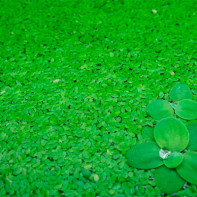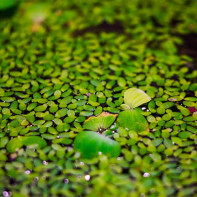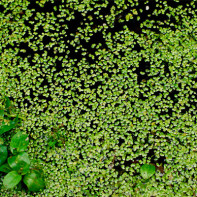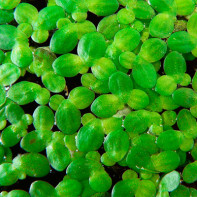Duckweed: medicinal properties and contraindications
In the summer, on ponds and in the backwaters of small lazy rivers, the surface is covered by a continuous green carpet. He sways slowly under the wind, reluctantly parting before the geese entering the water. The zealous owners scoop up the green mass with a net and carry them in carts to bird yards where they feed the ducks. On such food, they grow 1.5 times faster. Few people think that duckweed is suitable not only for bird food, but harbors many useful properties used in folk recipes. Herbalists are well aware of them and part of the time in the summer necessarily devote to the collection and procurement of this useful product.
- How it looks and where it grows
- Views
- Collection and storage
- Chemical composition
- The healing properties of duckweed
- Duckweed in traditional medicine
- Psoriasis and Vitiligo
- Glaucoma
- Nephritis
- Allergy
- Impotence
- Herbal mixture for the treatment of thyroid nodules
- Poultices
- Infusion and tincture
- Cooking duckweed
- Green sorrel and duckweed cabbage
- Vitamin Salad
- Green oil
- Contraindications
How it looks and where it grows
If you examine one plant carefully, it turns out that it consists of a leaf blade, from which a whitish root goes down, and new processes develop in the sides in the form of the same leaf. Over time, they will reach the desired size and separate from the mother plant. Thus, the multiplication and proliferation of duckweed colony occurs. She belongs to the Aroid family, lives for several years. Flowering can be seen very rarely, small nondescript flowers are almost invisible on a green background.
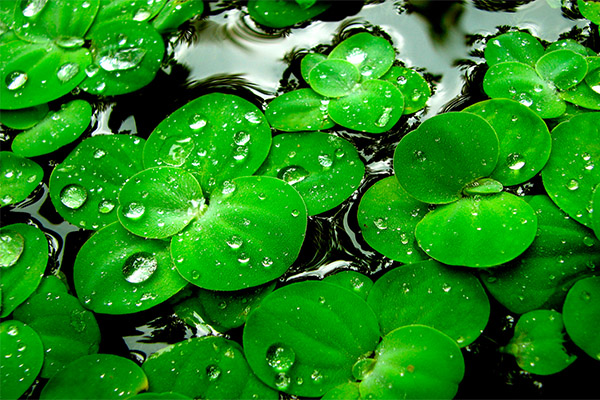
Representatives of the species are found in all countries, excluding the most northern zones. In salt water, they do not survive, spreading only in fresh water. The peculiarity of the plant is that for growth and development it does not need contact with the soil, it obtains everything necessary by photosynthesis, absorbing nutrients through small translucent floating roots.
The first plants begin to develop already at +6 degrees, the bulk appears only when the air temperature reaches + 24–28. The duckweed does not tolerate frost and immediately dies.
Nature gave duckweed a unique opportunity to successfully survive the cold. In autumn, a large proportion of starch is accumulated in the leaves and a turion bud is formed. Since the new formation is much heavier than water, it gradually sinks to the bottom and calmly hibernates, rising again to the surface as soon as the temperature becomes comfortable.
It is worth considering: when breeding duckweed in decorative ponds, it will be very difficult to remove it. It is very tenacious and grows fast again.
Sometimes a plant is planted in an aquarium, where it quickly fills the upper tier with itself and becomes an additional source of vitamins for fish, who eat it with pleasure or collect small particles of settled food from the inside of the leaves.
Views
So far, 14 species are known, spread from the tropics to the northern regions. It is possible that over time, new species will open. In Russia, 4 species are most common.
- Small has a sheet diameter ranging from 2.5 to 6 mm. It reproduces very quickly. One plant, still not completely separated from the mother, already gives a new baby. It has an amazing level of vitality. With a short withdrawal from the water, it dries up, but if it did not stay in the air for long, it comes to life again, it is worth returning it to its familiar environment. The structure of the plant is primitive. From the center of the leaf blade, the root with a thickening at the end falls down. It is 4–5 times longer than the leaf in length and acts as a food and stabilizer, preventing duckweed from turning over in the wave.
- Three-lobed duckweed is easy to identify in appearance, it is not divided into mother and daughter, and is interwoven with a single mesh, which is held under the surface of the water. For the winter, it also hides at the bottom of the reservoir.
- Humpback duckweed has an interesting structure.Additional buoyancy is given to it by a small air chamber located in the bosom of the leaf and dissected by partitions. Outwardly, it looks like coarse foam. Each plant contains a large amount of protein with minimal fiber. It is considered an excellent addition to traditional feeds, slightly exceeding their nutritional value, and is included in the diet of waterfowl. Interestingly, the presence of duckweed in the pond protects it from decay. This quality is used when populating the humpback variety in aquariums and ponds, where fish are bred on an industrial scale.
- The common multi-root is different from other species by the presence of several roots in one plant at once. Other characteristics are very similar.
Wolfless rootless is not typical for our country; it was discovered in the Moscow River. There is speculation that she got there as an aquarium resident. It differs from others in its elementary structure and lack of root.
The most common is small duckweed, it is intertwined with a humpback, and it can be difficult to discern from the shore which species populated the pond.
Collection and storage
All types have healing properties. They do not need to be collected separately; there is no specific time, when the properties of the plant are maximized, either. They go hunting for it throughout the summer, capturing warm autumn days.
Important: You can only collect duckweed in ecologically clean reservoirs.
For the convenience of the process, a net on a long handle and a bucket are taken with them. The collected material is washed in 3-4 waters, thoroughly remove foreign impurities, allow excess moisture to drain. The resulting mass is laid out in a thin layer on paper or cotton. For drying choose a shaded, well-ventilated place. Direct sunlight destroys the fine structures, several times lowering the medicinal properties of the plant.
Chemical composition
Duckweed leaves contain a whole range of nutrients:
- vitamins A, C, E, B, PP;
- tannins;
- organic acids;
- Proteins
- cellulose;
- polysaccharides;
- amino acids;
- flavonoids;
- phosphorus;
- calcium;
- magnesium;
- cobalt;
- vanadium;
- copper;
- bromine.
Moreover, they are in forms and compounds that are easily absorbed by the body almost without waste.
The healing properties of duckweed
This plant, of course, is not ginseng, but there is some benefit from it. First of all, its nutritional properties are used, powder from dried raw materials is added to ready-made dishes for the treatment of anemia and its prevention. This supplement is given to children who are poorly gaining weight or hyperactive toddlers who require much more energy than they get with food. Also duckweed has:
- antipyretic;
- choleretic;
- general strengthening;
- painkillers;
- immunostimulating effect.
There are almost no contraindications to its use, it does not cause allergies, is well absorbed, does not provoke the development of obesity.
Duckweed in traditional medicine
Duck grass is used in several directions, making infusions from it, decoctions, applying as compresses, a food supplement. It is part of recipes that alleviate the symptoms of skin diseases, pathologies of the cardiovascular and genitourinary system. Infusions are used as an anthelmintic, tonic. A good result is the treatment of duckweed with conjunctivitis, gastrointestinal disorders, rheumatism, gout, allergic reactions. Adding duckweed to food returns masculine strength, increases physical stamina, and promotes concentration.
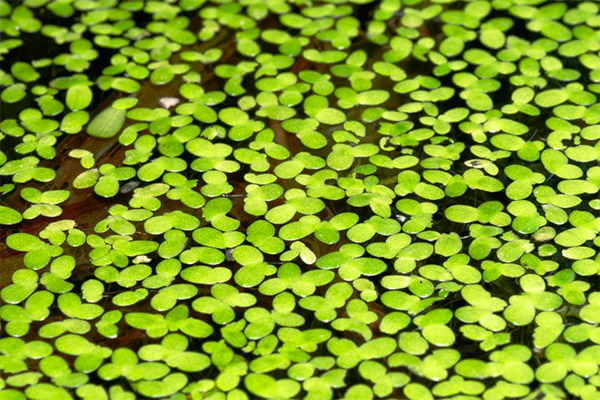
Duck grass is used in dried and fresh form. It is part of decoctions, ointments, tinctures. The choice of dosage form depends on the nature of the disease and the individual reactions of the body.
Psoriasis and Vitiligo
To prepare the product, duckweed and good flower honey are used in 1: 1 proportions. Fresh duckweed in the amount of 1 bucket is washed and dried, triturated into a fine powder. Then the resulting mass is mixed with honey and small balls weighing 2 g are formed. It is recommended to use a pharmacy balance to determine the exact dosage. The balls are dried in a cool shady place and put in a tightly closed jar. Store in a refrigerator on a shelf for vegetables. Treatment is carried out 3 times a day for six months. Then they take a break of 60 days and continue the next course. It will take 5–6 years to achieve a complete cure.
Duckweed can also be used for babies suffering from these skin diseases, but a decoction of 1 tbsp is prepared for them. tablespoons of raw materials and a glass of water. After boiling, the mixture is kept on the stove for no more than 3 minutes. Then they put it on a wooden board or stand, cover the pan with a towel and insist for at least an hour. The filtered remedy is given to children over 1 year old for 1 tbsp. spoon 4 times a day.
For external use, an ointment is prepared, consisting of 9 tbsp. tablespoons of dry raw materials and 10 g of melted butter. Both components are thoroughly mixed until smooth and stored in a cool place, lubricating the affected skin. The same tool is effective for softening the nose during rhinitis. With otitis media, ointments soaked with ointment relieve pain, suspend the inflammatory process.
Glaucoma
In this disease, complex therapy is recommended, including medications aimed at stopping destructive processes, and herbal preparations to maintain the level of immunity. Water infusion is prepared only from fresh duckweed. In order not to interrupt the treatment, for the winter period they pre-stock tincture of herbs on vodka. For cooking, take 2 tbsp. spoons with a hill of dried duckweed and a glass of vodka. The mixture is insisted for 4 days, stored in a dark place away from sunlight and heating appliances, take 10 ml 3 times a day, after stirring in 1/4 cup of water.
Nephritis
The diuretic and anti-inflammatory effect of duckweed is enhanced by burdock seeds. This product is used dry with plenty of water. Dried chopped duckweed and seeds are taken in equal proportions, mixed, taken 1 teaspoon before each meal in at least 20 minutes. The course is 30 days.
Please note: The first signs of improvement occur only after 2-3 weeks of taking the drug, since it has a cumulative effect.
Not recommended for children under 5 years old.
Allergy
Most often, it manifests itself during the flowering period of plants. But you can’t sit all summer in a locked apartment, depriving yourself of the joys of communicating with nature. She also offers a simple and effective means of combating allergic reactions of mild to moderate degree. With rapid swelling of the respiratory tract, duckweed will not help, you will have to turn to strong medicines. To relieve minor symptoms and eliminate discomfort associated with an allergy, just 1 tbsp. spoonful of duckweed pour a glass of boiling water and insist 1 hour in a thermos. Infusion take 100 ml 4 times a day before meals.
Impotence
Pharmacy products give a quick, but short-term effect, having a whole list of contraindications and side effects. One of them is a negative effect on the cardiovascular system. Dried duckweed gradually restores lost functions without harming other systems of the body. For treatment, it is enough to eat 2 teaspoons in the morning in a mixture of duckweed powder with honey. For convenience, you can roll balls of 1 cm in size from these ingredients.
Herbal mixture for the treatment of thyroid nodules
The endocrine system is difficult to treat, because it is difficult to maintain a balance in hormone production.Often such problems lead to surgery. To avoid surgical intervention, it is recommended to use in complex treatment herbal preparations that act gently and sparingly, without disrupting the gland. To compile the collection you will need one part:
- duckweed;
- a frat;
- zyuznik;
- violets;
- burdock root;
- starlets;
- yarrow.
Herbs are crushed, mixed. The broth is prepared from 1 tbsp. tablespoons of the mixture and a glass of water. First, the raw material is poured and defended for an hour. Then it is placed for 20 minutes in a water bath. The cooled broth is filtered and added with boiled water to the original volume. Take during the day in three equal portions. After 2 months, you must go through an ultrasound scan and get tested. After a 14 day break, the course is repeated. To consolidate the positive dynamics will need about six months.
Poultices
Prepared from crushed fresh mass, boiled for 2-3 minutes in boiling water. Then duckweed is kneaded, wrapped in cotton and used to relieve joint pain, hemorrhoids, insect bites.
Infusion and tincture
Duckweed does not like prolonged heat exposure, therefore, for the preparation of medicines, they try to immediately boil it with boiling water and cover it with a towel or mix with an alcohol-containing liquid.
The peculiarity of the infusion is a short shelf life. It is stored only a day, then loses useful properties. It is better to cook before use and in small quantities. He has few restrictions on the use, the remedy can be given to children and pregnant women after consulting a doctor.
Tinctures have a longer cooking process, but they will be stored in a cool dark place for almost a year. For preparation, you need 1 teaspoon per 50 ml of vodka or alcohol diluted to 45%. You can use the brew of double purification. The tool is insisted for a week, then filtered and stored in a tightly closed jar or bottle. Do not freeze and heat. The dosage for admission is 20 drops, the frequency is 3 times a day. It is used in the treatment of:
- oncology;
- bronchial asthma;
- vitiligo;
- allergies.
It is not worth drinking in its pure form, it is necessary to dilute it in 1/3 cup of warm water.
The tincture is also useful in chronic edema, catarrh of the upper respiratory tract, runny nose, urticaria, iodine and iron deficiency, vitamin deficiency, malaria, and diabetes mellitus.
Cooking duckweed
Modern stores are staggering with food abundance. It is a pity that in the first lines of many products in the list of substances are dyes, stabilizers and flavor enhancers. The benefits of such delicacies are doubtful, but there is a lot of harm. Vitamins are also best obtained not in the form of tablets, but to create an internal supply of natural products.
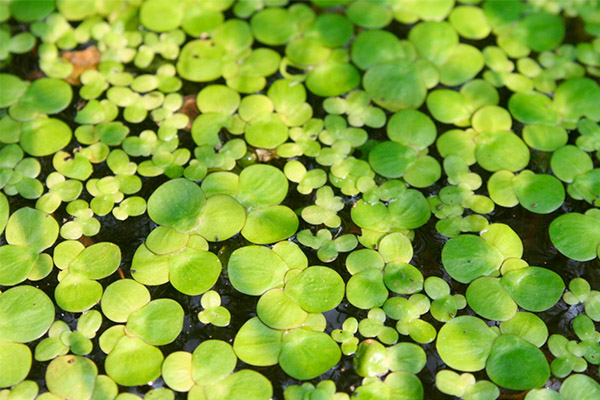
Duckweed is used as a food supplement. It does not have a bright taste and is almost invisible in the general combination, but its benefits are much greater than that of sodium glutamate.
Interesting: the nutritional value of duckweed is comparable to legumes, cereals, leaf lettuce.
It is not necessary to grow it, it reproduces itself perfectly, sometimes completely covering the water surface of small reservoirs that do not have a strong current. Dried duckweed is useful as a dressing for borsch. Fresh leaves are added to soups, salads, make vitamin oil from them.
Green sorrel and duckweed cabbage
The basis is chicken stock, 2-3 finely chopped potatoes, 5-6 fresh champignons, previously fried in vegetable oil, and onion are added to it. Greens are added 3-4 minutes before being cooked. Served in semi-serving plates, seasoned with sour cream.
Vitamin Salad
The composition includes sauerkraut, duckweed, boiled potatoes, onions and green onions, garlic feathers, dill. Salad oil is suitable for refueling. The finished mixture is sprinkled with an egg, passed through a coarse grater.
Green oil
Used for making sandwiches. 2 tbsp.tablespoons of fresh duckweed are boiled for 5 minutes, passed through a meat grinder and mixed with softened butter. The mixture has a pleasant light green color and a delicate taste, increases immunity and appetite.
Contraindications
It is noticed that in emotionally unstable people duckweed provokes excessive irritability, and with vegetative-vascular dystonia it can cause a sharp contraction of blood vessels. During pregnancy and breastfeeding, it is best not to experiment. Individual intolerance and allergies are also included in the list of contraindications.
The duckweed contains many opportunities that are not yet fully understood, it is useful, and it is very easy to assemble it. The main thing is to avoid industrial areas and go to her places away from factories and roads. Dried plants can be purchased at the pharmacy.
«Important: all information on the site is provided exclusively in fact-finding purposes. Before applying any recommendations, consult with a profile specialist. Neither the editors nor the authors are liable for any possible harm caused materials. "

